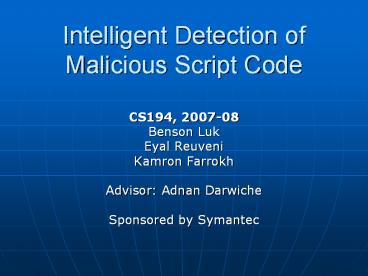Intelligent Detection of Malicious Script Code - PowerPoint PPT Presentation
Title:
Intelligent Detection of Malicious Script Code
Description:
... and develop an effective structure for storing data and link it to webcrawler ... Webcrawler will be used to grab additional URLs, and Norton Antivirus will be ... – PowerPoint PPT presentation
Number of Views:138
Avg rating:3.0/5.0
Title: Intelligent Detection of Malicious Script Code
1
Intelligent Detection of Malicious Script Code
- CS194, 2007-08
- Benson Luk
- Eyal Reuveni
- Kamron Farrokh
- Advisor Adnan Darwiche
- Sponsored by Symantec
2
Outline for Project
- Phase I Setup
- Set up machine for testing environment
- Ensure that whitelist is clean
- Phase II Crawling
- Modify crawler to output only necessary data.
This means - Grab only necessary information from webcrawling
results - Listen into Internet Explorers Javascript
interpreter and output relevant behavior - Phase III Database
- Research and develop an effective structure for
storing data and link it to webcrawler - Phase IV Analysis
- Research and develop an effective algorithm for
learning from massive amounts of data
3
Completed Tasks First Quarter
- Phase I
- Configured machine with Norton Antivirus and
Heritrix web crawler - Webcrawler will be used to grab additional URLs,
and Norton Antivirus will be used to verify that
a URL has not launched an attack - Created a Python script to ensure that visited
sites are clean - Captures Nortons web attack logs before and
after loading a site in Internet Explorer, then
compares the logs for new entries and signals
whether or not a sites data should be discarded - Phase II
- Configured Heritrix to run specific crawls that
target a set of domains, and output minimal
information - The purpose is to gather as many URLs with
scripts as possible for a large sample base - Created a parser for Heritrix logs to filter out
irrelevant websites - For example, we are omitting URLs that point to
images since they will not contain scripts
4
Completed Tasks Second Quarter
- Phase I
- Whitelist integrated Symantec component to check
whether visited site is malicious, so all of the
data we gather is from clean sources - Hard drive installed a 750 GB hard drive
5
Completed Tasks Second Quarter
- Phase II
- Crawling We ran a shallow crawl with 200 domains
as seed, and that is the current base of our
data. The result was 18,500 URLs that we run
through with our Script Listening component
6
Completed Tasks Second Quarter
- Phase II
- Script Listening received a customizable tool
from Symantec that listens to the Javascript
interpreter in Internet Explorer - We modified it to output the information we need
- GUID -gt DISPID -gt ArgType -gt ArgVal
7
Completed Tasks Second Quarter
- Example of data
DISPID (function) GUID (object) of Args Arg Type Arg Value
1030 3050f55f-98b5-11cf-bb82-00aa00bdce0b 1 BSTR 130
8
Completed Tasks Second Quarter
- Phase III
- The amount of data we have gotten is too large to
use in a database. The pure text file is 4GB (50
million function calls), and querying such a
database is too slow on the computer we have. - Instead, we are storing the data as a text file,
and doing operations on it with Python scripts.
9
Results and Findings Second Quarter
- Phase IV
- We have analyzed data from our first two result
sets - Crawl with 5 initial seeds
- 3,476,348 function calls
- 109 distinct GUIDs, 7364 GUID-DispID pairs
- Crawl with 15 initial seeds
- 3,706,454 function calls
- 95 distinct GUIDS, 5575 GUID-DispID pairs
- Looked at most common functions, most common
int-argument functions, and distribution of the
argument values for these functions
10
Results and Findings Second Quarter
- Function 1
- GUID 3050f55d-98b5-11cf-bb82-00aa00bdce0b
- GUID object name DispHTMLWindow2
- DispID 1103
- Most popular int-argument function in both result
sets - Mostly random distribution, but signs of
regularity - Results from two sets show significant differences
11
Results and Findings Second Quarter
12
Results and Findings Second Quarter
- Function 2
- GUID 3050f55f-98b5-11cf-bb82-00aa00bdce0b
- GUID object name DispHTMLDocument
- DispID 1013
- Second most popular int-argument function in both
result sets - Shows a regular distribution with distinct
characteristics - Results from two sets show significant differences
13
Results and Findings Second Quarter
14
Results and Findings Second Quarter
- Function 3
- GUID 3050f51b-98b5-11cf-bb82-00aa00bdce0b
- GUID object name DispHTMLIFrame
- Dispid -2147418107
- Third most popular int-argument function 1st
result set, 95th most popular in 2nd result set - Shows a random distribution with distinct
characteristics - Results are dramatically different between data
sets - All arguments in the 2nd result set are 0
15
Results and Findings Second Quarter
16
Results and Findings Second Quarter
- Found significant differences between the data
sets in both the frequencies of specific
functions, and the arguments of specific
functions - Suspect that differences result from biases due
to small amount of original seeds (5 and 15) - Ran a much broader crawl (200 seeds) in hopes of
getting more general, unbiased results - Just from partial results of this crawl (roughly
8000 websites), we have so far found - A much larger average of calls to our listener
per website - A large percentage of function calls that take 0
arguments - Will post complete results once crawl is finished
17
Direction for Next Quarter
- Further analyze the gathered data for patterns
- Compare trends in normal data to what occurs in
malicious scripts































![[Latest Update] CompTIA CS0-003 Actual Exam Practice Questions Shared Online PowerPoint PPT Presentation](https://s3.amazonaws.com/images.powershow.com/10140963.th0.jpg?_=20240927016)